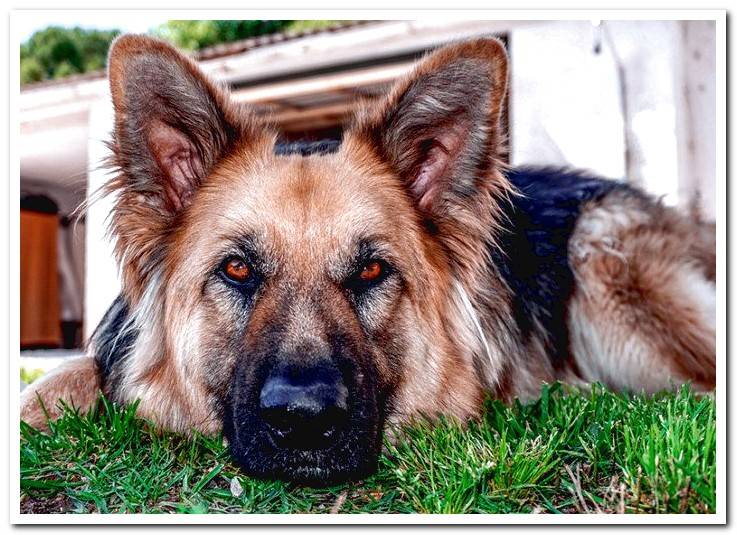
As with humans, dogs are also susceptible to emotional disturbances. So, just as we care about their physical problems, psychological illnesses are important to the well-being of our dogs.
Pathologies associated with behavior and emotions can be of great diversity of types and have very different origins. Next, we offer you information about the most common psychological illnesses in dogs.
Index of contents
- 1 How do psychological illnesses originate in dogs?
- 2 Types of common emotional disorders in dogs
- 2.1 Depression
- 2.2 Obsessive-compulsive disorder (OCD)
- 2.3 Separation anxiety
- 2.4 Phobias
- 2.5 Schizophrenia
- 2.6 Other mental disorders in dogs
- 3 Tips to take care of your dog’s mental health
How do psychological illnesses originate in dogs?
Most of the frequent mental disorders in dogs appear during the first four months of the animal’s life. These disorders are mainly related to education and socialization mistakes that humans make with the dogs and the environment in which they develop.
However, adult dogs can also show abnormal signs of behavior. Therefore, the origin of these diseases is variable and their causes are of enormous diversity.
Some of the most frequent causes are:
- Trauma, such as neglect, abuse, etc.
- Deficiencies and limitations of the breed.

Types of common emotional disorders in dogs
Although any dog is susceptible to numerous pathologies on an emotional level, these are the most common.
Depression
It is not known if the depressive process of dogs is the same as that of people, veterinaryns agree on the existence of this disease after the presence of the following symptoms:
- Inactivity
- Excessive sleep
- Apathy
- Loneliness
- Behavioral and character changes
- Irritability
- Decayed tail
- Eating disorders
- Lack of emotion when stimulated
- Compulsive licking
This is one of the most common mental disorders in dogs.. Furthermore, if depressive levels rise too high, this disease can cause the death of the animal due to self-destructive behaviors and / or malnutrition.
The causes of a dog’s depression are highly variable; having suffered mistreatment or abuse, tense and / or solitary environments or situations, changes in routine, the death of a loved one or animal, hormonal disorders, jealousy, etc.
- Learn more about depression and how to diagnose it at: How do you know if a dog is depressed?
Obsessive-compulsive disorder (OCD)
These types of disorders are detected when the dog is observed performs actions repeatedly and uncontrollably, such as licking, biting, digging, or spinning. Even after training to try to stop these behaviors, the dog will continue to carry them out.
As in the previous case, the causes are varied, from abandonment or abuse, to anxiety about not meeting their needs or living in very small spaces. In addition, some research indicates that in certain cases this disorder is hereditary.
- Learn more about OCD from: How to tell if a dog has OCD
Separation anxiety
This problem usually occurs in dogs with excessive emotional dependence on their owners. By separating from these, the dogs acquire anxious behaviors. The causes are again varied, but are always observed when the dog is separated from its loved one.
Although it is probably the most common emotional disorder in dogs, it is not a problem that owners should overlook, since the dog suffers and develops an excessive dependency. Stress, fear and anguish take over him and make him present the following symptoms.
- Barking, crying, howling and / or moaning
- Tachycardia
- Escape attempts
- Tremors
- Vomiting
- Excessive drooling
- Scratch
- To relieve yourself at home
- Self-harm
- You can learn more about this pathology from: Separation anxiety in dogs

Phobias
Another of the common psychic problems in dogs appears when the dog feels an exaggerated and very intense fear of something, such as the loud sounds of rockets, firecrackers and storms or people who at some point caused a traumatic event for the dog.
Some of the symptoms that puppies with phobias feel are:
- Tremors and / or nervousness
- Avoidance
- Sporadic escape attempts
- Crying and / or moaning
- Tachycardia
- Excessive drooling
- Heavy breathing
The fear that a dog with a phobia feels about something is so excessive that it is very difficult to deal with. Its complete elimination is rarely achieved So you often choose to handle the situation as you can.
If your dog has a specific phobia, you can avoid frequenting those places where there is a great chance that it will run into its fear or entertain the animal in some way when the phobia appears, such as turning up the volume on TV when there is a storm or firecrackers.
Schizophrenia
This disease affects complex thought forms and, although it may seem strange, it also occurs in dogs. A schizophrenic dog will show strange behavior changes that previously did not present, such as those described below:
- Aggressiveness towards signs of affection
- Self-harm with blows
- Fights with other dogs
- Meaningless barking
Other mental disorders in dogs
- Aggressiveness
- Personality disorder
- Dysthymia or bipolar disorder
- Intelligence deficit disorder
Tips to take care of your dog’s mental health
Psychological illnesses often have one thing in common: they are very difficult to treat. If you suspect that your furry has a disorder, the first thing you should do is visit the vet to diagnose any possible problem and put appropriate treatment.
In addit
ion to following the possible treatment of the vet or ethologist, you can help take care of your dog’s mental balance doing regular exercise with him, socializing him with other dogs, giving him the attention he needs and maintaining a pleasant and peaceful environment for him.
Remember that well-being, both in humans and dogs, is achieved in body and mind. Pay attention to your dog’s needs in both ways and you will have a happy dog.
